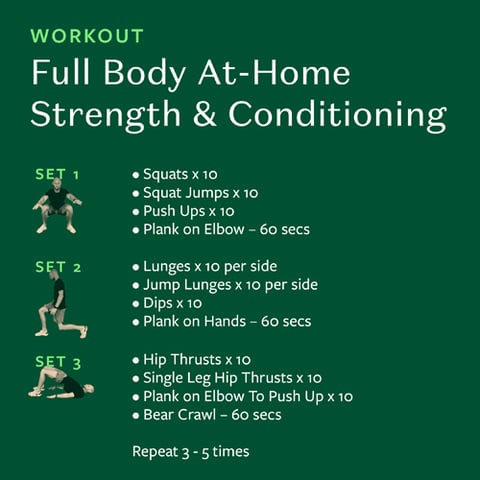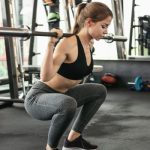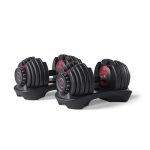At-home workouts are convenient and effective. No gym membership is required.
You can improve your fitness right from your living room. Conditioning workouts at home offer flexibility and efficiency for busy schedules. They focus on building strength, stamina, and overall health without fancy equipment. This type of workout can be tailored to suit your fitness level and goals.
Whether you’re a beginner or experienced athlete, home conditioning exercises provide a great way to stay active and healthy. With the right plan, you can make the most of your time and space, all while working towards a fitter you. Dive into the world of home conditioning workouts and discover how these can transform your fitness routine.
Benefits Of Home Workouts
Home workouts have gained popularity for their numerous benefits. Many find these exercises easy to incorporate into daily routines. They offer a great way to stay fit without leaving your house. Home workouts can be tailored to fit personal needs and goals.
Convenience And Flexibility
Home workouts provide unmatched convenience. No need to commute to a gym. Exercise at any time of day or night. This flexibility helps maintain a consistent routine. Adjust workouts to fit into your busy schedule. Choose exercises that match your energy level and mood.
Cost-effectiveness
Home workouts save money. No gym membership required. Invest in basic equipment once. Use everyday items as workout tools. Online resources offer free workout plans. Budget-friendly and efficient.

Credit: www.corecollective.sg
Essential Equipment
Working out at home can be simple and effective. You don’t need fancy machines or a gym membership. With the right equipment, you can create a solid workout routine. This guide will show you the essential tools for a home workout. Start with the basics, and add more as you progress.
Bodyweight Basics
Bodyweight exercises are a great starting point. They need no equipment. Push-ups, squats, and lunges are effective and free. These moves use your body’s weight to build strength. Perfect for beginners and experienced athletes alike.
Bodyweight training helps improve flexibility and balance. It’s adaptable to any space. No need for a large area. Just a small corner in your living room will do.
Optional Add-ons
Once you master bodyweight exercises, consider adding tools. Resistance bands are a good choice. They are affordable and versatile. Use them for strength training and stretching. They take up little space, making them perfect for home gyms.
Dumbbells are another option. They help increase the intensity of workouts. Start with a light set and gradually increase the weight. Adjustable dumbbells save space and money.
A yoga mat is useful for floor exercises. It provides comfort and prevents slips. Great for yoga, pilates, or core workouts. These add-ons enhance your routine, offering variety and challenge.
Warm-up Routine
Starting your workout with a warm-up routine is crucial. It prepares your body for exercise, reduces injury risk, and boosts performance. A good warm-up gets your blood flowing and muscles ready for action.
Dynamic Stretches
Dynamic stretches are a great way to start your warm-up. They involve moving parts of your body and gradually increasing reach, speed, or both. Think of movements like leg swings, arm circles, and torso twists.
- Leg Swings: Stand next to a wall and swing one leg forward and backward. This helps loosen your hip joints.
- Arm Circles: Extend your arms and make circles, starting small and gradually increasing the size.
- Torso Twists: Stand with your feet hip-width apart and twist your torso from side to side.
These stretches can make a big difference. You might notice improved flexibility and better mobility. Try adding them to your routine and see how your body responds.
Cardio Warm-up
A quick cardio warm-up gets your heart pumping. Even just five minutes can make a significant impact. Jumping jacks, jogging in place, or skipping rope are effective choices.
- Jumping Jacks: Start with your feet together and jump while spreading your arms and legs. It’s simple but effective.
- Jogging in Place: Lift your knees and pump your arms as if you’re running. This elevates your heart rate quickly.
- Skipping Rope: If you have a rope, use it to jump for a minute or two. It’s a fun and challenging way to warm up.
Cardio warm-ups increase your heart rate and prepare your muscles for more intense activity. Have you ever noticed how a short burst of cardio can wake you up and make you feel more energetic? It’s an easy way to boost your workout.
Think about your current warm-up routine. Are you doing enough to prepare your body? By including dynamic stretches and cardio, you can enhance your workout effectiveness. Try these tips and see the difference in your performance!
Strength Training Exercises
Strength training exercises are vital for building muscle and boosting metabolism. At home workouts can effectively target major muscle groups. No fancy equipment needed. With simple moves, strength can be increased. Focus on key areas of the body.
Upper Body Moves
Push-ups work wonders for chest and arms. They require nothing but your body weight. For beginners, start on your knees. Gradually progress to full push-ups.
Tricep dips strengthen the back of your arms. Use a sturdy chair or a low table. Keep your elbows close to your body.
Planks challenge your shoulders and core. Hold the position for 30 seconds. Increase duration as you get stronger.
Lower Body Moves
Squats are essential for leg strength. Stand with feet shoulder-width apart. Lower your body as if sitting in a chair.
Lunges target thighs and glutes. Step forward with one leg. Lower your hips until both knees are bent.
Calf raises improve lower leg strength. Stand on tiptoes and hold for a few seconds. Repeat several times.
These exercises can be done in a small space. Consistency is key for best results.
Core Conditioning
Core conditioning strengthens the muscles around your trunk and pelvis. It improves balance and stability. A strong core supports the spine and enhances posture. At home, you can perform effective core workouts without equipment. These exercises suit all fitness levels.
Plank Variations
Planks are excellent for core strength. They target the abs, back, and shoulders. Begin with the basic forearm plank. Keep your body in a straight line. Hold for 30 seconds or more. Side planks engage the oblique muscles. Lie on your side and lift your hips. Hold your body in a straight line. Switch sides after 30 seconds. Try the reverse plank for a challenge. Sit with legs extended and lift your hips. Your body should form a straight line. Hold for 30 seconds.
Abdominal Workouts
Crunches are a classic ab exercise. Lie on your back with knees bent. Place hands behind your head. Lift your shoulders off the ground. Lower back down and repeat. Bicycle crunches add a twist. Lie on your back and lift legs. Alternate touching elbows to opposite knees. Engage your core throughout the movement. Leg raises target the lower abs. Lie flat and raise legs to the ceiling. Lower them slowly without touching the ground. Repeat for several reps.
Cardio Intervals
Cardio intervals are a fantastic way to pump up your at-home conditioning workout. They boost your heart rate and burn calories efficiently. You don’t need fancy equipment, just a bit of space and determination.
Imagine turning your living room into a cardio powerhouse. The beauty of cardio intervals is their adaptability. You can go all out or keep it gentle, depending on your mood and fitness level.
High-intensity Drills
High-intensity drills can transform your workouts. They push you to your limits and maximize calorie burn. Think jumping jacks, burpees, or mountain climbers.
These drills are perfect for when you’re short on time. A few minutes can make a big difference. Feel your heart racing and muscles firing with each move.
I remember my first burpee session at home—exhausting but exhilarating. You’ll feel the sweat trickling down and a sense of accomplishment when you finish.
Low-impact Options
Prefer something gentler? Low-impact options are your friend. They are kinder on your joints while still effective.
Consider stepping side to side or marching in place. These moves keep your heart rate up without the pounding impact. They’re perfect for days when your body needs a break from high-intensity.
I often opt for low-impact workouts when I feel sore. It’s amazing how much you can still achieve while going easy on your body.
Mixing high and low intensity can keep your workouts exciting and balanced. How will you challenge yourself today?
Whether you choose high-intensity drills or low-impact options, cardio intervals offer a dynamic way to enhance your fitness journey. Dive into your next workout with enthusiasm and see how far you can go!
Cool Down And Stretching
Finish your workout with a cool down and stretching routine. This helps relax muscles and improve flexibility. At home, it’s easy to integrate these steps for better recovery and overall conditioning.
Cooling down and stretching might seem like a gentle end to a workout, but it’s much more than that. This phase is crucial for your recovery and can help prevent injuries. As your heart rate returns to normal, stretching allows your muscles to relax and rebuild. Let’s dive into the essentials of cooling down with static stretches and breathing techniques.Static Stretches
Static stretches are a great way to improve flexibility and release tension in your muscles. Hold each stretch for 15-30 seconds, focusing on areas that felt the burn during your workout. Remember, stretching shouldn’t be painful, so ease into each position. Consider starting with a hamstring stretch. Sit on the floor with one leg extended and the other bent. Reach for your toes, feeling the stretch in the back of your leg. Quadriceps stretches are another must. Stand on one leg and pull your other foot towards your buttocks. This helps release tension built up in your thighs. Don’t forget your upper body. Stretch your arms across your chest, holding them with the opposite hand. This targets your shoulders and triceps.Breathing Techniques
Breathing techniques can enhance your cool down by promoting relaxation and focus. Deep breathing helps lower your heart rate and reduces stress. Try the 4-7-8 technique: inhale through your nose for 4 seconds, hold for 7 seconds, and exhale slowly for 8 seconds. This pattern can calm your mind and body. While stretching, be mindful of your breath. With each inhale, visualize your muscles lengthening. On the exhale, sink deeper into the stretch. Have you noticed how your breath becomes shallow during a workout? This is your chance to reset and rejuvenate. Control your breathing to aid in full recovery. Incorporating cool down and stretching into your routine makes a big difference. You’ll feel more balanced and ready for your next workout. What stretches will you include in your cool down today?Tracking Progress
Monitoring your progress in home conditioning workouts boosts motivation. It helps identify areas needing improvement. Tracking lets you celebrate achievements, making workouts more effective and rewarding.
Tracking your progress in an at-home conditioning workout is essential for staying motivated and achieving your fitness goals. It’s like having a roadmap that shows where you started and how far you’ve come. By keeping tabs on your progress, you can celebrate small victories and stay on track for bigger achievements.Setting Goals
Setting clear goals is the first step in tracking your progress. Decide what you want to achieve with your workouts. Do you want to build strength, improve endurance, or lose weight? Write down your goals and be specific. Instead of saying “get fit,” aim for “run 5k in under 30 minutes” or “do 20 push-ups without stopping.” Track your starting point. Measure your initial performance, like how long you can hold a plank or the number of squats you can do. These benchmarks will help you see improvements over time.Using Fitness Apps
Fitness apps are fantastic tools for tracking progress. They offer features that let you log workouts, monitor your heart rate, and set reminders. Choose an app that fits your needs. Some popular ones are MyFitnessPal for tracking calories and Fitbit for measuring activity levels. Share your progress on the app’s community feature. Connecting with others can provide motivation and accountability. Have you ever felt more driven after sharing your achievements with friends? Do you have a favorite way to track your fitness progress? Maybe you prefer pen and paper over apps, and that’s perfectly fine. The key is to find a method that keeps you engaged and motivated. Tracking progress isn’t just about numbers. It’s about acknowledging your hard work and keeping your fitness journey exciting. So, what’s your next fitness goal?Motivation And Consistency
Embarking on an at-home conditioning workout journey requires two crucial elements: motivation and consistency. These twin pillars not only drive your progress but also sustain your commitment over time. Many start with high hopes but falter along the way. So how do you keep the fire burning and the momentum going? Let’s dive into the essentials of creating a routine and overcoming challenges to ensure you stay on track.
Creating A Routine
Building a routine is like setting the foundation for a house. Without it, everything else crumbles. Start by setting specific days and times for your workout sessions. Consider your energy levels; are you a morning person or do you prefer evenings?
Write down your plan and stick it somewhere visible. Seeing it daily acts as a reminder. This simple act can boost your commitment. Have you ever missed a workout because you forgot?
Choose workouts you enjoy. If you dread them, you’re more likely to skip them. Mix cardio with strength training to keep it exciting. Each session should feel like an achievement, not a chore.
Overcoming Challenges
Challenges will arise, and how you deal with them can make or break your routine. Lack of time is a common excuse. But remember, even a 20-minute session is better than none. Short workouts can be surprisingly effective.
Feeling tired or unmotivated? Revisit your goals. Why did you start this journey? Sometimes, a mental reset is all you need. Could a quick pep talk with a friend or a motivational video reignite your spark?
Environment matters too. Create a space for your workouts. It doesn’t have to be fancy; just enough to feel dedicated. What small changes can you make to inspire yourself? A simple mat or a set of dumbbells can transform your mindset.
Stay connected with others on the same path. Share experiences, struggles, and triumphs. This sense of community can boost your morale and keep you accountable.
Motivation and consistency are within your reach. It’s about creating habits that fit your life and finding ways to overcome obstacles. What steps will you take today to strengthen your commitment to your at-home conditioning workout?

Credit: www.youtube.com

Credit: www.pinterest.com
Frequently Asked Questions
What Is The Best Workout For Conditioning?
High-intensity interval training (HIIT) is the best workout for conditioning. It boosts cardiovascular health and endurance. HIIT involves short bursts of intense exercise followed by rest. It enhances muscle strength and burns calories efficiently. Incorporate exercises like sprints, burpees, and kettlebell swings for optimal results.
What Is The 5 4 3 2 1 Workout Method?
The 5 4 3 2 1 workout method involves five exercises, each performed in descending sets. Start with five sets of the first exercise, then four sets of the second, and so on. This method provides a full-body workout, improving strength and endurance efficiently.
It’s suitable for all fitness levels.
What Is The 3-3-3 Rule Gym?
The 3-3-3 rule gym is a workout routine involving three sets of three exercises, each lasting three minutes. It focuses on maximizing efficiency and intensity in a short time frame. This approach helps improve strength, endurance, and overall fitness in a structured manner.
What Is The 6 12 25 Rule?
The 6 12 25 rule helps manage finances. Save 6 months of expenses, allocate 12% for savings, and limit debt payments to 25% of income. This strategy ensures financial security and efficient budgeting for individuals seeking stable financial health.
Conclusion
Working out at home can be simple and effective. You don’t need fancy equipment. Just a bit of space and commitment. Start with basic exercises like squats and push-ups. Gradually increase intensity for better results. Regular exercise boosts energy and mood.
It’s important for overall health. Set realistic goals and track progress. Stay motivated by mixing up routines. Invite family or friends to join. Fitness is a journey, not a sprint. Keep moving forward with patience. Enjoy the process and feel proud.
Your home workout can lead to lasting changes. Stay consistent and see improvements over time.




